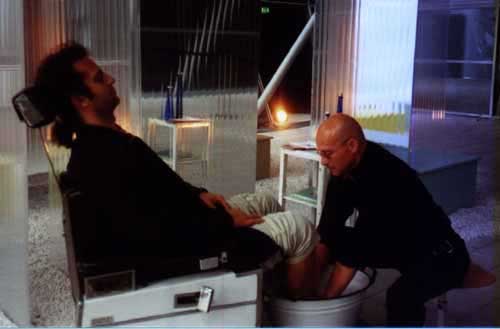 |
Feetwashing was a normal part of life in earlier ages, for roads were dusty and shoes expensive. Feetwashing was therefore a daily ritual, which was not considered as a gesture of devotion or submission, but as a mark of respect and esteem for fellow people. Even Jesus expressed his humility and knowledge of the significance of feet by making this gift to his fellow people and placing feet, traditionally thought of as worthless and impure, at the centre of general attention.
The aim of this ritualised ongoing performance/installation is the revival - and enjoyment! - with all its symbolic significance - in "normal everyday life", of this tradition, which is still, by the way, carried on today by bishops in the church every Maundy Thursday.
|
|
|
What we should know about feet
Feet have a highly interesting history. For biologists they are the most typically characteristic part of the human body. When the first humanoid beings stood upright 50 million years ago, the feet, originally constructed to bear a quarter of the body weight, had to get used to double the load. The spine had previously curved between forelegs and hind legs and had to adapt to the upright position. The big toe, similar to a thumb, moved into line with the other toes and the ankles moved down to the ground to help carry the weght of the body.
The best-known example of the role of feet in cultural history is the Achilles Tendon. The story goes that Achilles was dipped by his mother in the River Styx to make him invulnerable. She held him by an ankle. This tiny part of the body which was not immersed in water was in the end the death of him. The expression Achilles Tendon is still used today for weak points. Another legend tells of the Greek Foot and derives from the goddesses whose second toes were elongated. This was considered a sign of masculine strength, a high intellectual level and extreme sensuous eroticism. The virgin goddesses were therefore always depicted with covered feet, for feet were considered as especially intimate parts of the body.
Gesture of Submission
The Asian custom of kissing feet was considered a mark of submission to those of higher rank. Buddhists, Hindus and Moslems still today remove their shoes at the threshold of holy places and at home. This custom is also referred to in the Bible, when God says to Moses, "Take off your shoes, for the place where you are standing is holy ground."
In Chinese culture, the female foot was considered highly erotic. To make the feet the most attractive part of the body and to make them as petite as possible, they were bound, so that the bones could not develop properly to full size. This painful und senseless tradition is now, fortunately, history.
But many women still submit to the dictates of fashion and force their feet into highly elegant, but mostly uncomfortable, shoes, which with time deform their feet and hinder normal movement.
The feet are an expression of movement and individuality as life principles - "If you love me, then let me go".
Feet and legs symbolise the principle of movement in human life. We move through life with our feet. To stand on our own two feet and take the first independent steps is for each of us an extremely important phase in our development. Step by step we get to know the world and ourselves.
People take a big step forwards, stand on their own two feet or have both feet on the ground - these expressions point to the developments and changes in our lives and how we get control of and form our lives and meet the challenges of life. Many people go through life with certainty and energy, have a firm step, are rooted in life. Others move with uncertainty, with a light step, restlessly, as though they are looking for their place in life. To be able to stand on your own two feet and be responsible for yourself and take control of your own life shows a high level of individuality and maturity. Our feet have then carried us the whole long way through life and tell in their individual form and in the way they are cared for and how they react to pain of the level of maturity we have reached and the state of health of the whole person. It is also an interesting anatomical fact that the foot is the only place in the body where there is such a concentration of joints. Over 50 joints in each foot make for extreme mobility.
By massaging the feet, we can initiate movement, for the feet are at the same time a gateway to the person, and we step out through this gateway to conquer the world anew.
Feet and their Energy-Connection with the Earth
Feet also reflect the energy-connection with the earth, earthing, rooting. A person with good contact with the earth cannot be easily shaken. Such a person stands firm and can withstand a lot of outside influences - like a tree with deep roots which need have no fear of any storm...
More in a moment...
|
|
|
